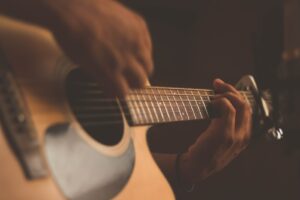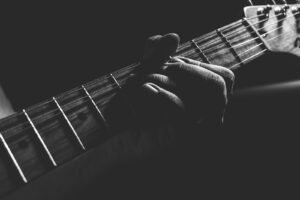The sound produced by an electric guitar is supposed to be different from that made by acoustic guitars.
The main reason electric guitar’s sound should be different is the pickups in electric guitars that change the strings’ vibrations into an electrical signal.
An amplifier then amplifies it.
There are some instances when electric guitars can sound like acoustic guitars.
When an electric guitar is connected directly to an amplifier with no additional sound effects, it can sound not electric.
In most instances, it sounds like an acoustic guitar.
It does this because the amplifier boosts the natural volume of the sound produced by the vibrating strings.
There is no alteration of its fundamental qualities.
Is it Possible to Play an Electric Guitar Without Pedals?
By adjusting the settings on your guitar and amplifier, you may still achieve a fantastic tone without using pedals. Even some amplifiers feature built-in modeling for effects.
You can choose between the neck and bridge pickups or a pair with the pickup switch.
To start with, understand the design of the guitar you are playing.
Most electric guitars have two or three pickup settings.
These settings allow one to change the tone to align with numerous musical genres and tones.
The sound you get from using only the neck pickup is more acoustic, while the sound you get from using the bridge pickup is rockier and ideal for guitar solos.
You may achieve a decent balance of both by using both!
Why Does My Electric Guitar Sound Acoustic?
When an electric guitar is not linked to an amplifier or if the amp knobs are misaligned, it may not sound electric but rather as acoustic.
In addition, if it is attached to a pedal that is simulating guitar sounds, it can sound acoustic.
A non-powered sound is going to be produced by an electric guitar.
The tone will resemble an acoustic guitar if it has any electric guitar equipment that is not working well.
Electric guitars may add various effects to enhance their tone, which sets them apart from their acoustic counterparts.
To differentiate your instrument’s tone from acoustic guitars as much as possible, you can use a variety of pedals, such as harsh overdrives, violent distortions, shapeshifters, reverbs, and delays.
Your electric guitar shouldn’t sound like an acoustic guitar, assuming you have all the appropriate equipment and have purposefully sought out a “fancy” tone.
If it does, we’ll briefly go through a few strategies you might want to attempt to achieve the ideal tone.
Inspect the Cable Input on Your Guitar
Even the most dependable guitar cable won’t help if your instrument’s cable input is broken, so check that first.
If the input is millimeters out of position, it blocks the cable from reaching the hardware.
If the input jack is loose, identify the screws holding it together and tighten them using the matching screwdriver.
Rarely, the slot may have moved a little more into the body (mainly if you pushed the cable into the jack).
In this situation, unscrew the jack, physically pull it back, and then tighten the screws until the jack stays in place.
It’s vital to remember that your guitar’s amplifier may potentially experience this issue. You can fix it by following the same methods.
Adjust the Settings on Your Amp
Your amplifier’s knobs, faders, and sliders significantly impact the tone and sound of your guitar.
Besides the volume knob, most newbies keep settings at the lowest level.
It makes the instrument remain the same as before.
Maybe a little louder.
It is a rather typical problem. By experimenting with features they don’t understand, beginners risk damaging their amplifier.
You must first understand these functions’ differences to tackle this problem.
The frequency range can frequently be modified using the sliders.
Your tone won’t significantly suffer from it (the frequency range will be flat) even if they’re all at 0 dB.
On the other hand, the knob with “gain” or “dist” shown can significantly alter the tone of your instrument.
Increase the gain by at least 50%. Although basic amps rarely have these settings, you might also want to look for knobs with names like “boost,” “presence,” and “pre-amp.”
You don’t want to keep the “Master” knob at a low setting.
Because several newcomers are unaware that this is the main volume knob, your amp won’t sound or will only be faintly audible until one turns it up considerably.
Check The Cable
Even more seasoned guitarists tend to minimize the value of a decent guitar wire.
You likely received a free off-brand cable if you recently bought a beginner’s guitar kit.
If at all, it might not operate correctly.
Even if connected to a powered amp, your electric guitar may sound unplugged due to damaged, twisted, or ruptured connections.
Examine the guitar cable’s entire surface with care.
You should be able to wrap it quickly, and the surface should be flawlessly smooth.
If that’s not the case, you’re most likely using an old or shoddy-made cable.
Both scenarios could result in the cable failing to transfer power from the amp to your instrument.
Purchase a new cable, ideally from a reputable music store, to solve this problem.
Verify the Correct Sequence of Your Signal Chain
If you don’t use any effects pedals, there is one way to connect your amp to your guitar.
The amp won’t play music if you don’t connect two cables to the proper jacks while utilizing pedals.
All left to do is inspect your pedal for “In” and “Out” markings, assuming you have invested in high-quality cables and all the jacks are functional.
Connect the first cord to your amplifier and the other end to the pedal’s “In” jack.
Connect the second cable’s “Out” jack on your pedal to one end and your guitar’s jack to the other.
If you’re utilizing many pedals, the scenario is very different.
You will not only need several guitar cables to connect them, but you’ll also need to arrange them correctly.
Randomly connecting your FX pedals could negatively affect your tone or completely cut the signal.
Crank the Tone Knobs on Your Guitar
All guitars feature at least a few knobs (or a sliding pot), just like amps.
These controls often control the instrument’s tone, loudness, and chosen pickup.
Your guitar will be silent if these dials are at zero, giving you an acoustic-like tone.
In other words, neither pickup (if there are two) will be chosen, and its internal volume will be set to “silent.”
You should turn these knobs the other way.
It should at least make it significantly different from an acoustic guitar, even if the tone is not excellent.
References
https://guitardivision.com/electric-guitar-sounds-like-acoustic/
https://musicaroo.com/why-does-my-electric-guitar-sound-acoustic/




